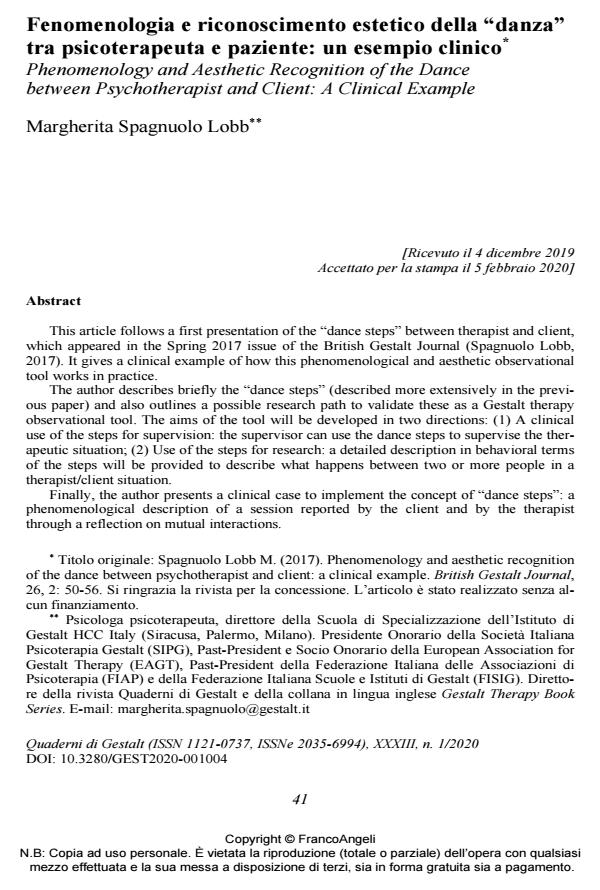Fenomenologia e riconoscimento estetico della "danza" tra psicoterapeuta e paziente: un esempio clinico
Titolo Rivista QUADERNI DI GESTALT
Autori/Curatori Margherita Spagnuolo Lobb
Anno di pubblicazione 2020 Fascicolo 2020/1
Lingua Italiano Numero pagine 16 P. 41-56 Dimensione file 201 KB
DOI 10.3280/GEST2020-001004
Il DOI è il codice a barre della proprietà intellettuale: per saperne di più
clicca qui
Qui sotto puoi vedere in anteprima la prima pagina di questo articolo.
Se questo articolo ti interessa, lo puoi acquistare (e scaricare in formato pdf) seguendo le facili indicazioni per acquistare il download credit. Acquista Download Credits per scaricare questo Articolo in formato PDF

FrancoAngeli è membro della Publishers International Linking Association, Inc (PILA)associazione indipendente e non profit per facilitare (attraverso i servizi tecnologici implementati da CrossRef.org) l’accesso degli studiosi ai contenuti digitali nelle pubblicazioni professionali e scientifiche
Questo articolo fa seguito alla presentazione dei "passi di danza" tra terapeuta e paziente, pubblicata in un articolo del numero della primavera 2017 del British Gestalt Journal (Spa-gnuolo Lobb, 2017) , e fornisce un esempio clinico di come questo strumento di osservazione fenomenologica ed estetica funziona nella pratica. Inoltre delinea un possibile percorso di ri-cerca. Il presente contributo ha come quadro di riferimento la capacità di risposta (respons-abilità) politica e sociale degli psicoterapeuti nel contesto contemporaneo. Per l’autrice, una principale fonte di sofferenza oggi deriva dalla mancanza di riconoscimento dell’altro, che si evidenzia nella desensibilizzazione corporea dei nostri pazienti. Questo rende necessario che gli psicoterapeuti della Gestalt si focalizzino sulla reciprocità delle loro interazioni con i pazienti, piuttosto che su come il paziente fa contatto. Infatti, è proprio lì, nella "danza" tra loro, che è presente la possibilità di rivitalizzare il confine di contatto, luogo in cui il sé è co-creato.
Parole chiave:Passi di danza tra terapeuta e paziente, fenomenologia, estetica, desensibilizza-zione, reciprocità.
- Bloom D.J. (2007). “Tigre! Tigre! Che splendente bruci”: valori estetici come valori clinici in psicoterapia della Gestalt. In: Spagnuolo Lobb M., Amendt-Lyon N (a cura di), Il permesso di creare. L’arte della psicoterapia della Gestalt, Milano: FrancoAngeli (ed. or.: “Tiger, Tiger, Burning Bright”. Aesthetic values as clinical values in Gestalt Therapy. In: Spagnuolo Lobb M., Amendt-Lyon N. (Eds.), Creative license. The Art of Gestalt Therapy, Vienna & New York: Springer, 2003).
- Damasio A. (1999). The Feeling of What Happens: Body and Emotion in the Making of Consciousness. New York, NY: Harcourt Brace.
- Gallese V., Eagle M.N., Migone P. (2007). Intentional Attunement: Mirror Neurons and the Neural Underpinnings of Interpersonal Relations. Journal of the American Psychoanalytic Association, 55, 1: 131-176.
- Gallese V., Spagnuolo Lobb M. (2012). Il now-for-next tra neuroscienze e psicoterapia della Gestalt. Idee in Psicoterapia, 5, 13: 53-65.
- Heidegger M. (1953). Essere e tempo. Torino: Utet (ed. or. Sein und Zeit. Niemeyer, Verlag: Halle 1927).
- Merleau-Ponty M. (1945). Fenomenologia della percezione. Milano: Bompiani (ed. or.: The Phenomenology of Perception. Abingdon, UK: Routledge, 2009).
- Panksepp J. (1998). Affective Neuroscience: The Foundations of Human and Animal Emotions. New York, NY: Oxford University Press.
- Perls F.S., Hefferline R., Goodman P. (1997). La terapia della Gestalt: eccitazione e accrescimento nella personalità umana. Roma: Astrolabio (ed. or.: Gestalt Therapy: Excitement and Growth in the Human Personality. New York, NY: The Gestalt Journal Press, 1951; 1994).
- Porges S. (2014). La teoria polivagale. Fondamenti neurofisiologici delle emozioni, dell’at tac camento, della comunicazione e dell’autoregolazione. Roma: Giovanni Fioriti (ed. or.: The Polyvagal Theory: Neurophysiological Foundations of Emotions, Attachment, Communication, and Self-regulation. New York, NY: W.W. Norton & Company, 2011).
- Ricoeur P. (2005). Percorsi del riconoscimento. Milano: Raffaello Cortina (ed. or.: Parcours de la reconnaissance. Paris: Editions Stock, collections “Les Essais”, 2004).
- Siegel D.J. (2012). La mente relazionale: neurobiologia dell’esperienza interpersonale. Milano: Raffaello Cortina (ed. or.: The Developing Mind: How Relationships and the Brain Interact to Shape Who We Are. New York, NY: The Guilford Press, 1999).
- Spagnuolo Lobb M. (2016). Psychotherapy in Post Modern Society. Gestalt Today Malta, 1, 1: 97-113.
- Spagnuolo Lobb M. (2017). From Losses of Ego Functions to the Dance Steps Between Psychotherapist and Client. Phenomenology and Aesthetics of Contact in the Psychotherapeutic field. British Gestalt Journal, 26, 1: 28-37.
- Stern D.N. (2005). Il momento presente in psicoterapia e nella vista quotidiana. Milano: Raffaello Cortina (ed. or.: The Present Moment in Psychotherapy and Everyday Life. New York, NY: Norton, 2004).
- Stern D.N. (2011). Le forme vitali. L’esperienza dinamica in psicologia, nell’arte, in psicoterapia e nello sviluppo. Milano: Raffaello Cortina (ed. or. Forms of Vitality. Exploring Dynamic Experience in Psychology and the Arts. Oxford, UK; New York, NY : Oxford University Press, 2010).
- van der Kolk B.A., Roth S., Pelcovitz D., Sunday S., Spinazzola J. (2005). Disorder of Ex-treme Stress: The Empirical Foundation of a Complex Adaptation to Trauma. Journal of Traumatic Stress, 18, 5: 389-399.
- La supervisione in psicoterapia della Gestalt Margherita Spagnuolo Lobb, in QUADERNI DI GESTALT 1/2024 pp.7
DOI: 10.3280/qg2024-1oa17950
Margherita Spagnuolo Lobb, Fenomenologia e riconoscimento estetico della "danza" tra psicoterapeuta e paziente: un esempio clinico in "QUADERNI DI GESTALT" 1/2020, pp 41-56, DOI: 10.3280/GEST2020-001004